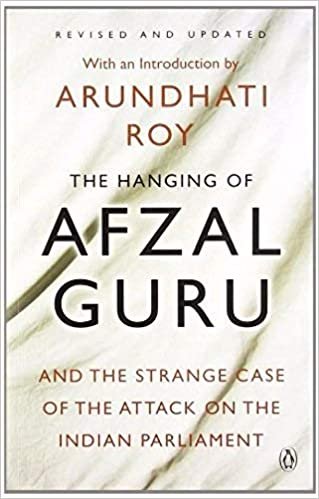The Hanging of Afzal Guru

Rating: 3.9/5
Author: Arundhati Roy
Publisher: Penguin Books
Publishing Date: 2013
Language: English
Genre: Non-Fiction
ISBN-10: 0143420755
ISBN-13: 978-0143420750
Format: Paperback
Pages: 304
Cost: Rs. 284 (Paperback), Rs. 203.30 (Kindle Edition)
Plot:
This book brings together essays by lawyers, academics, journalists and writers who have looked closely at the available facts of the 2001 Indian Parliament attack and have raised serious questions regarding the investigations and the trial of the convicts involved in this conspiracy. This book also examines the implications of Mohammad Afzal Guru’s hanging and what it says about the Indian government’s relationship with Kashmir.
Review:
Who is Afzal Guru?
He is considered to be the mastermind of the 2001 parliament attack conspiracy in India.
The infamous attack on the Indian parliament took place on 13th December 2001 when five armed men in a white Ambassador car loaded with explosives drove through the gates of the Indian parliament in an attempt to blow it up. In the ensuing gunfight, all the five were killed along with six Delhi Police personnel, two Parliament Security Service personnel and a gardener.
The accused were: (1) Mohammad Afzal Guru, a surrendered militant; (2) Shaukat Hussain Guru (cousin of Afzal Guru); (3) Afsan Guru, Shaukat’s wife, who was Navjot Sidhu before marriage and (4) Syed Abdul Rahman Geelani, a lecturer from Delhi.
After the unremitting investigation for eleven years on the death row, Afzal Guru was helping the prime responsible one and was hanged on 9 February 2013.
This book presents a collection of essays by the various people who were not convinced of the guilt of the conspirators and tried to save them from the punishment. They were successful in the case of two but could not save Afzal. Three-fourths of the book cover the period when he was on death row, waiting for a possible presidential pardon. The last part is related to his hanging and its aftermath.
All the writers wholly focus on two things:
1. the guilt against Afzal Guru has not been proven at all, and there has been grave injustice to this pronounced justice.
2. they are layers of secrecy covering the parliament attack case, which have not been brought to light.
‘The Hanging of Afzal Guru’ also reports the heinous crimes, conducted by security forces during custody of Kashmiri youngsters. Overall, the book enriches the readers with facts that has never been out in the open, earlier and sort of uncovers the complete truths and the hidden lies behind this conspiracy.
About the Author:
Arundhati Roy was born in 1960 in Kerala, India. She studied architecture at the Delhi School of Architecture and worked as a production designer. She has written two screenplays including Electric Moon (1992) that was commissioned by Channel 4 television.
Her first novel ‘God of small things’ won the Booker Prize for Fiction in 1997. An immediate bestseller, the novel was published simultaneously in 16 languages and 19 countries but caused controversy in India for the description of a love affair between a Syrian Christian and a Hindu 'untouchable'. She is also the author of several non-fiction books including: The Cost of Living (1999) - a highly critical attack on the Indian government for its handling of the controversial Narmada Valley dam project and for its nuclear testing programme; Power Politics (2001)- a book of essays; and The Algebra of Infinite Justice- a collection of journalism. The Ordinary Person's Guide to Empire was published in 2004. She has since published a further collection of essays examining the dark side of democracy in contemporary India ‘Listening to Grasshoppers: Field Notes on Democracy’ (2009).
Her latest book is ‘The Ministry of Utmost Happiness’ (2017), her second novel. It was longlisted for the Man Booker Prize and, in the US, was a finalist for the National Book Critics Circle Award. For her work as an activist she received the Cultural Freedom Prize awarded by the Lannan Foundation in 2002.















































